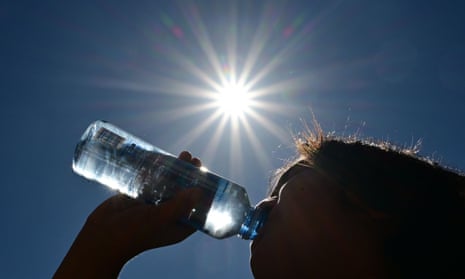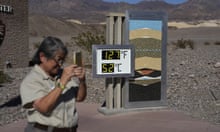A record-breaking heatwave has scorched the US west, the latest in a string of extreme temperature events putting communities on high alert for heat-related illness and death as temperatures are expected to spike higher through the holiday weekend.
More than 50 million Americans live in areas now under excessive heat watches, warnings and advisories. Temperatures are expected to hit 115F (46C) in the coming days across parts of southern California, Sacramento and the San Joaquin Valley, according to the National Weather Service. In Death Valley, temperatures were forecast to reach more than 120F (49C) – and perhaps match the highest temperature observed globally in the month of September.
On Wednesday afternoon, heat records for this time of year broke in several California communities, including those near Los Angeles and San Diego. In Burbank and Woodland Hills, a suburb north of Los Angeles, temperatures rose to an alarming 112F (44C) smashing previous August records.
#Border32Fire [update] The fire is now 1,600 acres. Fire continues pushing east and has crossed Highway 94 on the eastern portion of the fire, now burning on both sides of Highway 94. Over 400 residential units are affected by evacuations. pic.twitter.com/j52aQdSAHv
— CAL FIRE/SAN DIEGO COUNTY FIRE (@CALFIRESANDIEGO) September 1, 2022
The extreme heat also helped spur new wildfires across the state. The Route fire, which erupted in the triple-digit heat and prompted closures of Interstate 5 as residents in the area were forced to flee. The fire spread quickly, consuming thousands of acres in mere hours. Seven firefighters battling the blaze suffered heat-related injuries according to the Los Angeles county fire department, which added five of them were taken to hospitals for care.
FIRIS has mapped the #RouteFire at 4,625 acres. Structure threatened in the 32000 block of Castaic Lake Drive in the next 30-45 minutes. pic.twitter.com/YD1xGCH8m8
— Cascadia Fire Has No Season (@barkflight) September 1, 2022
The California department of emergency services said additional fire resources had been prepositioned in high-risk areas across the state as officials prepare for conditions to intensify through the weekend.
“The National Weather Service is forecasting widespread extreme fire weather over parts of the central coast and southern California through the weekend and into next week,” officials said in an update on Wednesday, noting that both essential equipment and additional personnel were made ready in Orange and Santa Barbara counties. “The public is urged to remain aware of their surrounding conditions and to avoid outdoor activities that can cause a spark near dry vegetation,” they added, urging residents to have emergency plans in place and load their vehicles with fuel to prepare for a fast evacuation.
Temperatures are expected to build throughout the week, with northern and southern California bracing for the highest temperatures during the long weekend. Extreme heat warnings have been triggered up and down the state, including in the San Francisco Bay area.

Parts of the Pacific north-west, Nevada, Idaho and Montana will also face dangerous temperatures. Boise, Idaho, is expected to finish August with an average temperature of 80F (27C) – the highest since record keeping began in 1875. Temperatures are expected to be eight to 12 degrees above normal in north-west Arizona, south-east California and southern Nevada.
Across many of these areas, temperatures are expected to cool only slightly overnight – elevating the risk for heatstroke and deaths, especially for vulnerable populations who lack air conditioning.
The extreme temperatures are a result of a “heat dome” bearing over the region – a ridge of high atmospheric pressure that acts as a lid, trapping in heat. Although climate crisis doesn’t cause heat domes, scientists expect it to drive more extreme weather.
The heatwave is just the latest of several to hit the US this summer. As they grow more frequent and intense, California has debated naming and ranking them – similarly to hurricanes – to underscore their significance. Extreme heat kills more people in the US than any other weather event, according to the National Weather Service. In interior northern California, the service has warned that “the entire population is at risk” of deadly heat.
California officials have warned that the heat could strain the state’s energy resources as demand for air conditioners and other appliances surge. The strain could be especially acute in a year that has already seen hydropower disrupted due to drought. With the heatwave just beginning, officials have called for residents to conserve energy where possible to avoid outages, describing the coming days as “the most extensive heatwave in the west so far this year” in a news release.
Additional “FlexAlerts”, a warning to conserve energy “are also possible through the Labor Day weekend as record setting temperatures are forecast across much of the west”, the state’s grid operator said.
High temperatures are also expected to accelerate the formation of ground-level ozone, or smog, which exacerbates respiratory issues. In southern California, officials have issued an ozone advisory due to the heatwave, advising people to stay indoors and avoid physical exertion.
Officials also warn that the high temperatures could further prime the parched, drought-addled west for wildfires. Parts of the west have already seen an explosive spring and summer, with major fires in the south-west and Alaska.
On Sunday, the Oregon governor, Kate Brown, declared a state of emergency due to the “imminent” threat of wildfire. “It is imperative that we act now to prevent further loss – of life, property, business and our natural resources,” she said.
In California, which has seen a relatively quiet fire season compared with recent years, officials advise that the heat will not only further dry and prime the landscape for explosive fire, but also increase the risk of ignitions. “With the warming and drying trend this week and over the weekend, we will see very dangerous heat risk and increased fire weather concerns over portions of interior northern California,” advised the National Weather Service in Sacramento.
The National Interagency Fire Center has warned of high fire risk in much of northern California, due to “warm temps, gusty winds”, low humidity, and “flammable fuels”.





